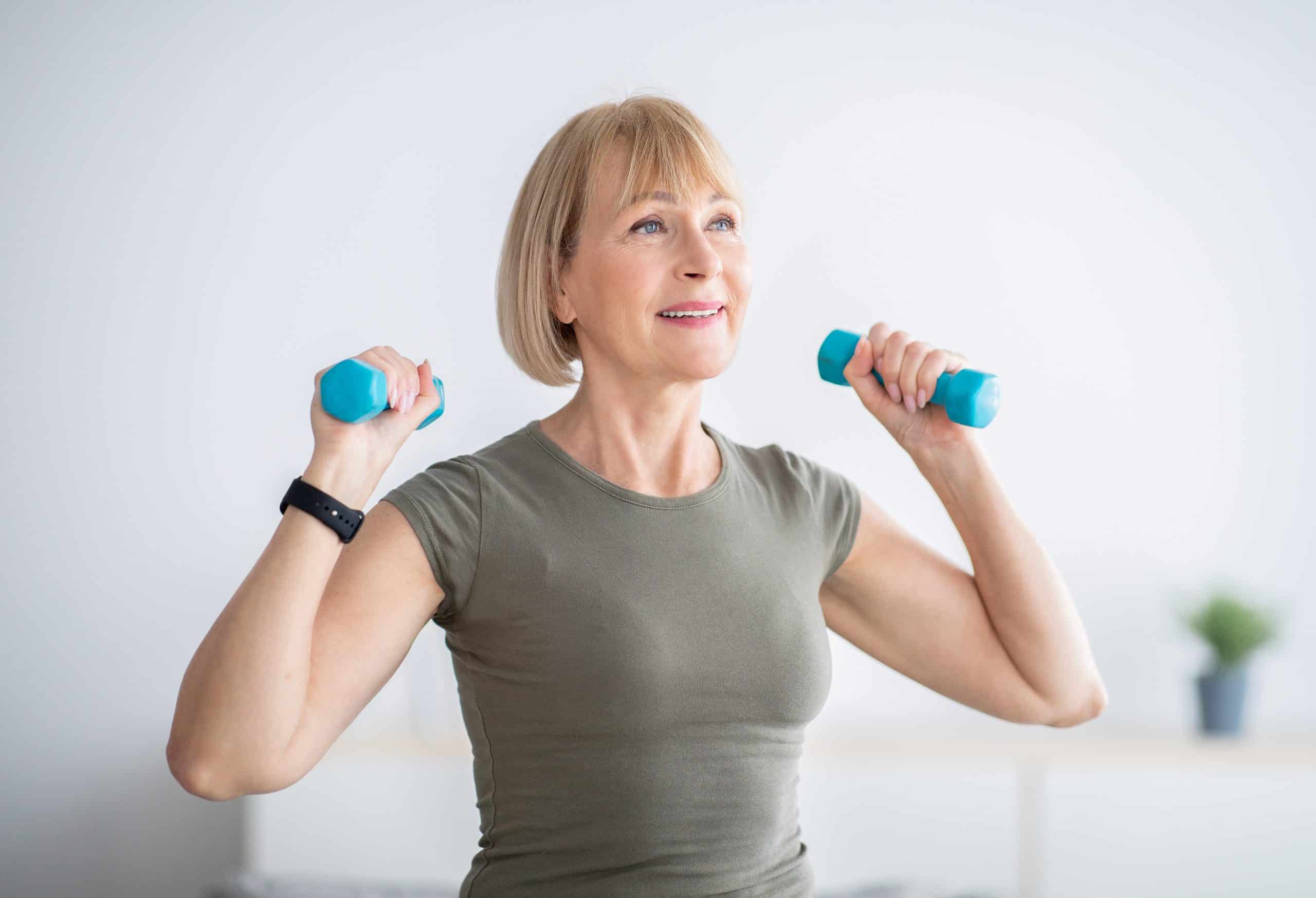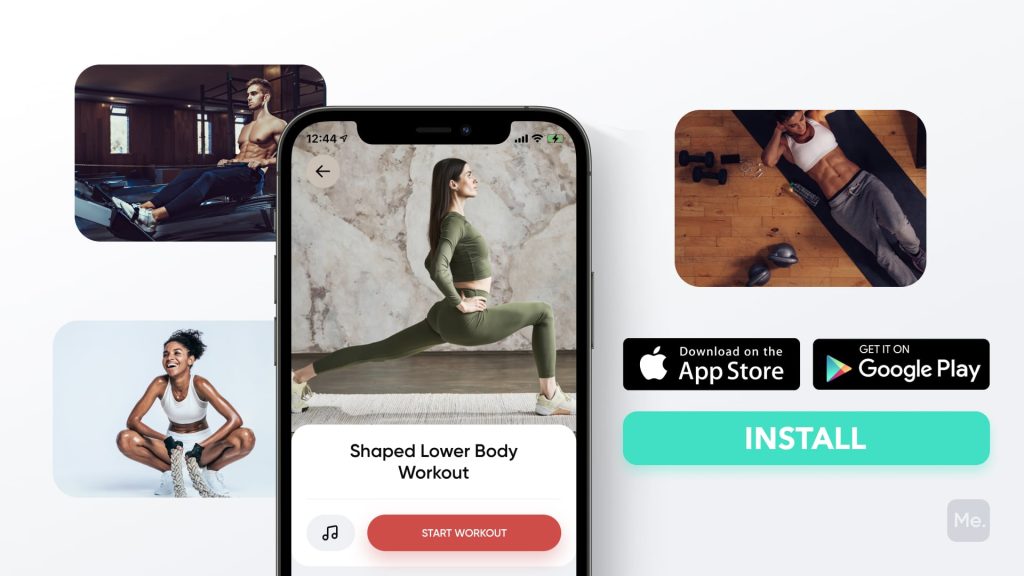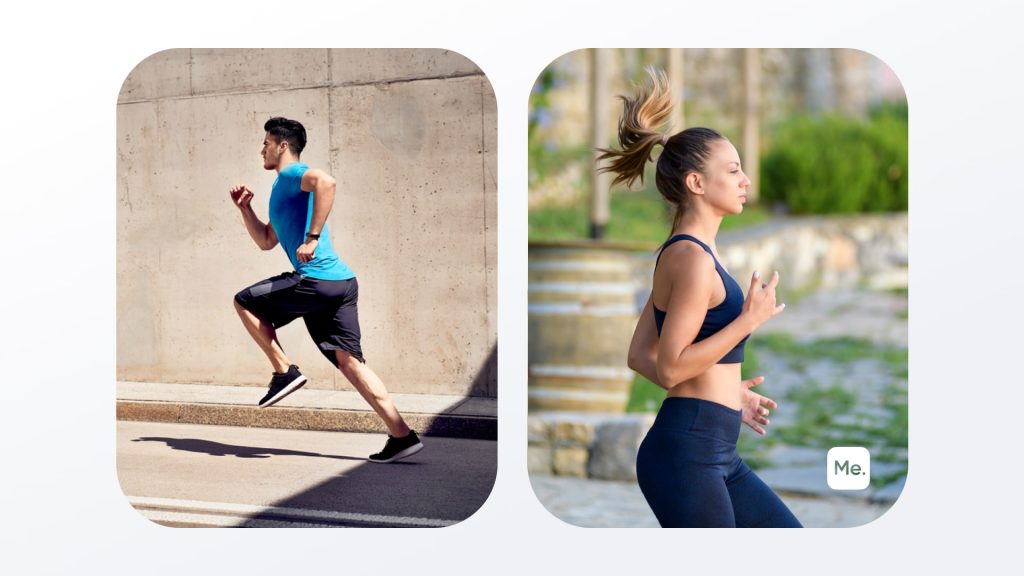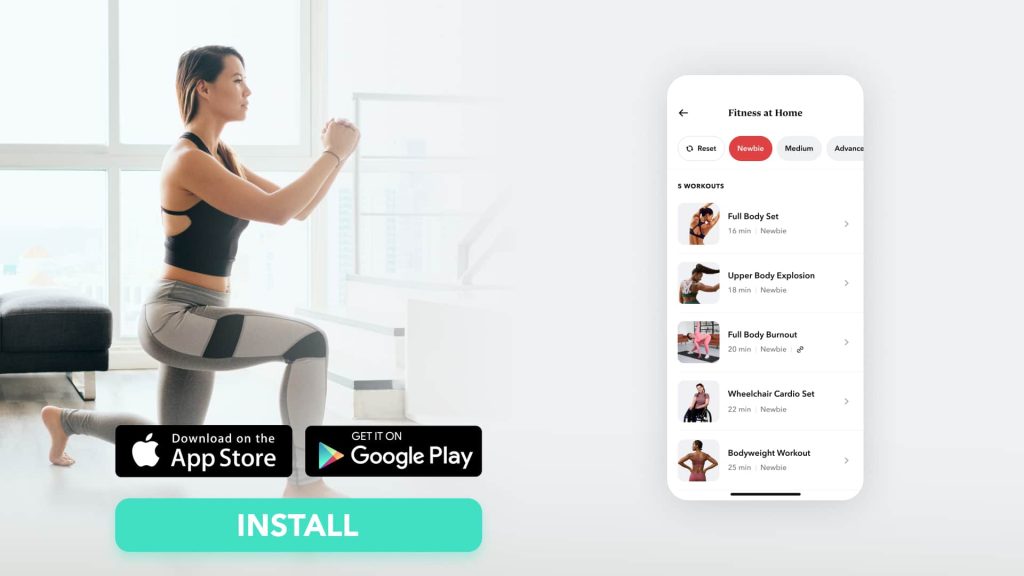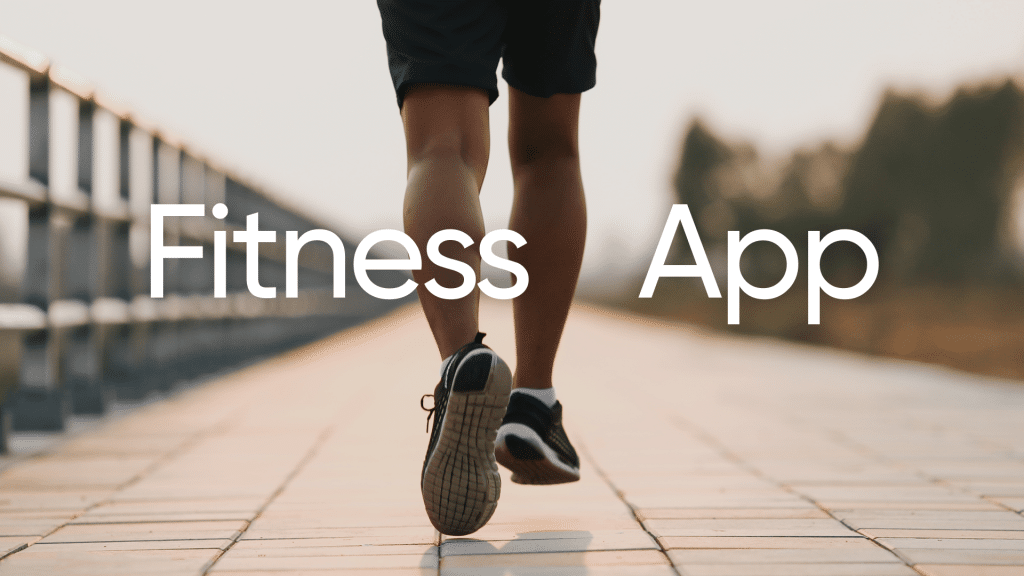As we age, certain changes occur in our bodies that can make exercise more difficult and potentially dangerous. Our bones become more brittle, our muscles weaker, and our joints less flexible. However, this doesn’t mean that we have to give up staying active and fit. According to the Centers for Disease Control and Prevention (CDC), seniors should get at least 150 minutes of moderate-intensity aerobic activity or 75 minutes of vigorous-intensity aerobic activity each week, as well as two days of muscle-strengthening activities (4). But what counts as moderate or vigorous intensity? And what are some safe, low-impact exercises that seniors can do to meet these recommendations? Here’s a look at some answers to these questions, as well as some tips on how to get started with a safe and effective exercise routine.
Get your personalized
meal plan!
What Is Moderate-Intensity Aerobic Activity?
Moderate-intensity aerobic activity is any activity that causes your heart rate to increase and makes you breathe faster and feel warmer. Examples include walking briskly, riding a bike on level ground, doubles tennis, pushing a lawn mower, or dancing.
To get an idea of how hard you’re working during moderate-intensity activity, the CDC offers this simple test: Can you carry on a conversation while you’re doing the activity, but can’t sing the words to a song? If so, you’re probably working at a moderate intensity.
What Is The Best Exercise For Over 70 Year Olds?
The best exercises for seniors are low-impact exercises that don’t put too much strain on the joints. In addition, low-impact activities benefit seniors by:
Staving Off Age-Related Weight Gain
As we age, we tend to lose muscle mass and our metabolism slows, both of which can lead to weight gain. Hormonal changes, such as those that occur during menopause, can also contribute to weight gain (1).
Low-impact activities that increase the heart rate and get us moving can help offset these age-related changes and keep our weight under control.
Improving Balance And Coordination
Becoming frail and unsteady on our feet is a common fear as we age. Regular exercise improves balance and coordination in a few different ways.
First, it helps maintain muscle strength and joint flexibility, both of which are necessary for good balance (8).
Second, it helps seniors become more aware of their bodies and how it moves in space. This can help them avoid falls and injuries.
It also allows them to participate in the simple, everyday activities that we often take for granted, such as getting in and out of a car or climbing stairs.
Read More: Low Intensity Steady State Cardio: Yay Or Nay?
Reducing The Risk Of Chronic Disease
According to the CDC, about two-thirds of Americans aged 65 and over have at least one chronic disease, such as heart disease, stroke, cancer, or diabetes (7).
Regular exercise can help reduce the risk of developing these conditions, as well as improve seniors’ overall health and quality of life.
For example, research has shown that exercise can lower blood pressure and cholesterol levels, improve insulin sensitivity, and reduce inflammation (6).
Easing Aches And Pains
Natural wear and tear on our bodies can cause aches and pains, especially as we age.
Exercise releases endorphins, which are hormones that block pain signals from the brain (2). In addition, regular exercise helps maintain muscle strength and joint flexibility, both of which can help reduce pain.
Improving Mental Health
Exercise isn’t just good for the body, it’s also good for the mind. Low-impact activities can help improve mood, reduce stress and anxiety, and increase energy levels. Exercise has even been shown to improve cognitive function and delay the onset of dementia (3).
Improving Bone Health
As we age, we start to lose bone density, which can lead to osteoporosis. Regular exercise can help prevent this by stimulating the growth of new bone cells (5). Weight-bearing activities, such as walking, are especially beneficial for bone health.
7 Of The Best Low Impact Exercises For Seniors At Home
When it comes to choosing safe exercises for seniors, there are a few things to keep in mind.
First, as we age, we’re more likely to have chronic health conditions or injuries that can make certain types of activities unsafe (7). Second, seniors are also more likely to have balance issues or other problems that can make high-impact activities risky.
For these reasons, it’s important to choose low-impact exercises that are safe and easy on the joints. Here are 10 of the best exercises for seniors:
1. Walking
One of the simplest and most effective exercises you can do at any age, walking is a great way to get your heart pumping and your muscles moving. For seniors, a moderate pace is best to avoid falls or injuries.
You want to choose a route that is free of obstacles and has an even surface. Avoid hills or areas with a lot of traffic. Start with 10-15 minutes and work your way up to 30 minutes or more.
Gearing up for a walk with the proper footwear is also important. Look for shoes with good arch support and a cushioned sole to absorb impact. Depending on the weather, you may also want to invest in a good sunscreen, sun hat, and sunglasses.
Whether you’re looking to simply pep up your fitness routine, jazz up your diet with mouth-watering low-calorie recipes or want to get your act together and significantly drop that number on your scale – BetterMe app has got you covered! Improve your body and revamp your life with us!
2. Tai Chi
Tai chi is a slow, gentle form of martial arts that originated in China. It involves a series of slow, fluid movements that are designed to improve balance and increase flexibility.
The beauty of tai chi is that it can be done anywhere – indoors or out. There is no equipment required, and it can be done at your own pace. Tai chi is also a great way to meet new friends and get some fresh air.
For seniors, there are many benefits of tai chi. Studies have shown that it can help improve balance and reduce the risk of falls. It has also been shown to help ease pain, improve sleep quality, and reduce stress levels.
Some basic tai chi moves include:
The “ward off”
- Start in a standing position with your feet shoulder-width apart.
- Raise your arms to shoulder height, elbows bent, and palms facing down.
- Slowly push your hands out in front of you, keeping your elbows close to your body.
- Return to the starting position.
The “push”
- Start in a standing position with your feet shoulder-width apart.
- Raise your arms to shoulder height, elbows bent, and palms facing down.
- Slowly push your hands out in front of you, keeping your elbows close to your body.
- Return to the starting position.
The “kick”
- Start in a standing position with your feet shoulder-width apart.
- Raise your right leg, knee bent, and foot pointing behind you.
- Slowly kick your leg out in front of you, keeping your heel close to your glutes.
- Return to the starting position.
Read More: Is Walking Cardio? Here’s What Experts Say
3. Yoga
Yoga is a mind-body practice that originated in India. It involves a series of postures and breathing exercises that are designed to improve flexibility, strength, and balance.
Yoga is a great exercise for seniors because it can be done at any fitness level. There are many different types of yoga, so you can find a class that is right for your needs.
Sofa yoga is a variation of yoga that is specifically designed for seniors. It includes a series of gentle movements that can be done while seated.
The support of the sofa helps to reduce the risk of falls and makes the more complex poses accessible. The result is one of the best low impact chair exercises for seniors!
Some basic sofa yoga moves include:
The “cat-cow”
- Start in a seated position on the edge of the sofa, with your feet flat on the ground and your hands on your knees.
- As you inhale, arch your back and look up at the ceiling.
- As you exhale, round your back and look down at your lap.
- Repeat this movement 10 times.
The “seated twist”
- Start in a seated position on the edge of the sofa, with your feet flat on the ground and your hands on your knees.
- As you inhale, lift your left hand up and over to the right side of the sofa.
- As you exhale, twist your torso to the right and look over your right shoulder.
- Hold this position for 5-10 breaths before returning to the starting position. Repeat on the other side.
The “seated forward bend”
- Start in a seated position on the edge of the sofa, with your feet flat on the ground and your hands on your knees.
- As you inhale, lift your arms up overhead.
- As you exhale, hinge at the hips and fold forward, keeping your back straight.
- Reach your arms out in front of you and let them dangle toward the floor.
- Hold this position for 5-10 breaths before returning to the starting position.
The “seated side bend”
- Start in a seated position on the edge of the sofa, with your feet flat on the ground and your hands on your knees.
- As you inhale, lift your right arm up overhead.
- As you exhale, hinge at the hips and reach your right hand down toward the floor on the left side of the sofa.
- Hold this position for 5-10 breaths before returning to the starting position. Repeat on the other side.
If you struggle to even flirt with the idea of giving up your favorite foods or working out till your legs give way – BetterMe app is here to breathe a fresh perspective into the way you view the weight loss process! Check out the app and experience the fun side of fitness and dieting with BetterMe!
4. Swimming
Swimming is an ideal exercise for seniors because it’s easy on the joints and provides a great workout. It’s also a great way to stay cool in the summer heat.
If you don’t know how to swim, there are many classes available for beginners. Or, you can start with some basic pool exercises and build up your confidence in the water.
Water aerobics for seniors is a great way to get started. These classes are usually held in shallow water and involve a series of low-impact movements. They’re a great way to get your heart rate up without putting too much strain on your body.
Some water aerobics exercises for seniors include:
The “Jog”
- Start in waist-deep water with your feet shoulder-width apart.
- Raise your knees up high and pump your arms as you would if you were jogging on dry land.
- Do this for 30 seconds to 1 minute.
Leg Lifts
- Start in waist-deep water with your feet shoulder-width apart.
- Raise one leg up in front of you and hold it for a few seconds before lowering it back down.
- Repeat with the other leg.
- Do this for 30 seconds to 1 minute.
Arm Raises
- Start in waist-deep water with your feet shoulder-width apart.
- Raise your arms out to the sides and up overhead, then back down again.
- Do this for 30 seconds to 1 minute.
Wall Sits
- Start by standing with your back against a pool wall.
- Slowly lower yourself down into a sitting position, keeping your feet shoulder-width apart and your knees bent at 90 degrees.
- Hold this position for 30 seconds to 1 minute.
Bicep Curls
- Start by holding a pool noodle in both hands, with your arms straight out in front of you.
- Keeping your upper arms still, bend your elbows and curl the noodle up toward your shoulders.
- Lower back down and repeat. Do this for 30 seconds to 1 minute.
5. Stretching
Stretching is important for seniors because it helps to improve flexibility and range of motion. This, in turn can help to prevent falls and injuries. The National Institute on Aging (NIA) recommends doing some form of flexibility exercise every day.
Target the muscles in the neck, shoulders, upper arms, upper body, chest, back, ankles, legs, hips and calves. These might sound like a lot of muscles, but there are many easy stretches that target all of them.
Using a chair for support, try some of these simple stretches:
The “neck stretch”
- Start by sitting up tall in a chair with your feet flat on the ground.
- Slowly turn your head to the right, then to the left.
- Hold each stretch for 30 seconds.
The “shoulder shrug”
- Start by sitting up tall in a chair with your feet flat on the ground.
- Shrug your shoulders up toward your ears, then release them back down.
- Repeat 10 times.
The “arm cross”
- Start by sitting up tall in a chair with your feet flat on the ground.
- Raise your right arm up and across your body, reaching toward the left side of the chair.
- Use your left hand to hold onto your right arm and deepen the stretch.
- Hold for 30 seconds, then repeat on the other side.
The “chest opener”
- Start by sitting up tall in a chair with your feet flat on the ground.
- Clasp your hands behind you and straighten your arms.
- Push your chest forward and hold for 30 seconds.
The “back scratcher”
- Start by sitting up tall in a chair with your feet flat on the ground.
- Raise your right arm up and over your head, then reach down toward the middle of your back with your fingertips open wide.
- Use your left hand to help guide the right hand down your back.
- Hold for 30 seconds, then repeat on the other side.
The “ankle grab”
- Start by sitting up tall in a chair with your feet flat on the ground.
- Reach down and grab your right ankle with your right hand.
- Gently pull your foot up toward your body until you feel a stretch in your calf muscle.
- Hold for 30 seconds, then repeat on the other side.
6. Lifting Weights
Lifting weights is a great way for seniors to stay strong and independent. It can help to improve bone density, increase muscle mass and reduce the risk of injuries. The NIA recommends doing some form of strength-training exercise two or more days per week.
There are many different ways to lift weights, but seniors should start with lighter weights and gradually increase the amount as they get stronger. They can also try using resistance bands or their own body weight for resistance.
Short, moderate-intensity workouts are best for seniors, so they should aim for 15 to 20 repetitions of each exercise and rest for 30 to 60 seconds in between sets. A total of 30 minutes of strength-training is ideal.
Splitting the workout based on muscle groups is also a good idea. For example, on Mondays and Thursdays, seniors can focus on the upper body, and on Tuesdays and Fridays, they can focus on the lower body. Wednesdays can be dedicated to core exercises.
7. Gardening And Other Light Yard Work
Gardening and other light yard work are excellent exercises for seniors. They provide a great way to get some fresh air and sunshine while also getting the heart rate up and burning some calories.
Some examples of light yard work that seniors can do include: raking leaves, pulling weeds, planting flowers, watering plants and mowing the lawn. All of these activities can help to improve strength, flexibility and balance.
The Bottom Line
Exercise is important for seniors, as it can help to improve strength, balance and overall health. There are many different types of exercises that seniors can do, but some of the best include walking, swimming, Tai Chi and light yard work. Seniors should talk to their doctor before starting any new exercise program.
DISCLAIMER:
This article is intended for general informational purposes only and does not serve to address individual circumstances. It is not a substitute for professional advice or help and should not be relied on for making any kind of decision-making. Any action taken as a direct or indirect result of the information in this article is entirely at your own risk and is your sole responsibility.
BetterMe, its content staff, and its medical advisors accept no responsibility for inaccuracies, errors, misstatements, inconsistencies, or omissions and specifically disclaim any liability, loss or risk, personal, professional or otherwise, which may be incurred as a consequence, directly or indirectly, of the use and/or application of any content.
You should always seek the advice of your physician or other qualified health provider with any questions you may have regarding a medical condition or your specific situation. Never disregard professional medical advice or delay seeking it because of BetterMe content. If you suspect or think you may have a medical emergency, call your doctor.
SOURCES:
- A Research Agenda: The Changing Relationship Between Body Weight and Health in Aging (2016, nih.gov)
- Endorphins and exercise (1984, pubmed.gov)
- Exercise for Mental Health (2006, nih.gov)
- How much physical activity do adults need? (2022, cdc.gov)
- Physical Activity and Bone Health (2014, nih.gov)
- Physical Activity Prevents Chronic Disease (2020, cdc.gov)
- Prevalence of Multiple Chronic Conditions Among US Adults, 2018 (2020, cdc.gov)
- The Effect of Balance and Coordination Exercises on Quality of Life in Older Adults: A Mini-Review (2019, nih.gov)
